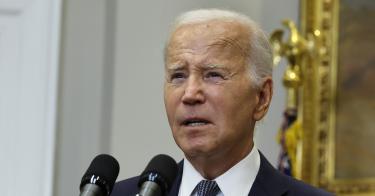A few weeks after the Supreme Court disabused President Joe Biden of the notion that he could unilaterally cancel $430 billion in student loans, Biden has now announced that his administration will instead cancel $39 billion in student debt held by 800,000 borrowers.
Under the American Rescue Plan Act of 2021, the resulting cancellations would be tax-free.
The reduced scale of the new program might lead some observers to assume that the president learned something from the Supreme Court’s rebuke. That would be a mistake.
Biden, with the help of Secretary of Education Miguel Cardona, continues to hallucinate an executive power to cancel student loans at will. The president seems to think he’s still a legislator, but now with a self-sufficient majority of one. He reads statutes as invitations to supplement the law with politically expedient amendments.
Under current law, student loan borrowers with income-driven repayment plans—ones with lower monthly payments calculated based on income—are eligible to have their remaining debt forgiven after they make a certain number of qualifying payments (totaling 20 years or 25 years, depending on the plan). In the Higher Education Act, Congress expressly authorized these programs, including eventual loan forgiveness, and set forth a list of criteria for determining when payments would count toward that forgiveness.
Biden maintains that his administration is merely correcting past undercounting and giving borrowers credit for progress they should have earned toward forgiveness.
That, however, is not the full story.
For starters, the administration has not offered the public evidence of the scale of the supposed miscounting. Administrative incompetence should not be underestimated.
Still, this is an unusually convenient time for the administration to discover such a failure, inasmuch as it enables Biden to attempt to accomplish part of the broad-ranging debt cancellation that the Supreme Court just kept him from implementing.
More importantly, the administration is doing more than counting previous qualifying payments. It is reimagining what payments and statuses qualify toward cancellation.
The Higher Education Act already specifies the requirements for getting credit toward the needed number of years, for instance, making the full payment one of the various income-driven repayment plans or having your loan deferred due to a bona fide “economic hardship,” a status the Higher Education Act defines by employment and income level.
To Congress’ limited criteria, Biden has added periods of forbearance, including the three years when borrowers saw no payment obligations or income accrual due to the COVID-19 pandemic.
He is also adding periods when borrowers paid less than the required monthly amount under their income-driven plan and/or periods when they paid late. Further, while Congress specified that only payments made under certain plans would count, Biden thinks it’s best if all payments are now counted, regardless of whether the borrower had a qualifying plan at the time.
The why is obvious: Biden wants to make more borrowers eligible for cancellation and to make their debt disappear faster, if not immediately.
But his authority for doing so is another question.
If Congress set out a list of qualifying events in the Higher Education Act, why does the president get to add to that list without involving Congress in his statutory rewrite?
Last fall, the administration released several legal memoranda purporting to justify its debt-canceling plan. Now, by contrast, the administration has been mum on the legal justifications for its latest actions.
In a separate rule-making, it gave the following view on the legal limits imposed by the Higher Education Act’s criteria: “This section does not specifically limit the calculation to only those periods or specifically preclude the Secretary from using the regulatory authority to add additional periods.” (Emphasis added.)
As legal justifications go, this is a poor one.
Congress does not draft statutes anticipating and expressly prohibiting every potential misuse for which a future president might invoke the law. Thus, Congress does not legislate a litany of specific “thou shalt nots” into every statute.
By looking only for explicit prohibitions, the administration behaves as though the president had some inherent policymaking authority where student loans are concerned.
That assumption is unsound.
The president’s duty is to execute the law as written, not to act as co-legislator augmenting Congress’ drafts long after they have passed into law.
Moreover, agencies such as the Department of Education have no inherent authority at all. Agencies are purely creatures of statute, wielding only those powers delegated to them by Congress. No agency enjoys a freewheeling power to amend laws via internal rule-making.
Even when agencies write rules to implement the policies embodied in a statute, they are constrained to offer legal authority for the changes and to make preliminary versions available for public notice and comment. Agencies are then obligated by law to respond to criticism and adjust their proposals as needed.
No such public process occurred here before the secretary of education implemented the changes to the periods counting toward debt cancellation.
In Biden v. Nebraska, the Supreme Court criticized Biden and Cardona for “red penciling” the Higher Education Act—deleting and then adding provisions to the law to create a novel student loan forgiveness program better tailored to the administration’s goals than Congress’ original handiwork.
At least in that case, Biden pointed to another law, the HEROES Act, as offering some basis for his authority to amend the Higher Education Act. Here, no other law is cited. Biden has simply asserted a power to augment the act unilaterally when it helps him accomplish part of his thwarted priorities.
This plan is not as gaudy and headline-grabbing as the mass cancellation announced last August and shot down in flames by the court late last month. Still, the smaller scale does not make it any sounder legally.
It is unclear whether this prong of Biden’s revised approach to student loans will face legal challenge. In principle, the arguments would be much the same as those made to the Supreme Court last term.
Taxpayer dollars are still at issue, as is Congress’ sole power to control the federal purse. At $1.7 trillion in total, student debt remains a major part of the economy that Congress has yet to address.
Here, again, Biden is moving forward with a forgiveness plan broader than anything Congress has created. And once more, the power he asserts to change the written law lacks a limiting principle, meaning that it could be applied to an ever-broadening class of borrowers until it becomes the primary means by which they discharge their student loan debt at a fraction of its value.
This piece originally appeared in The Daily Signal





